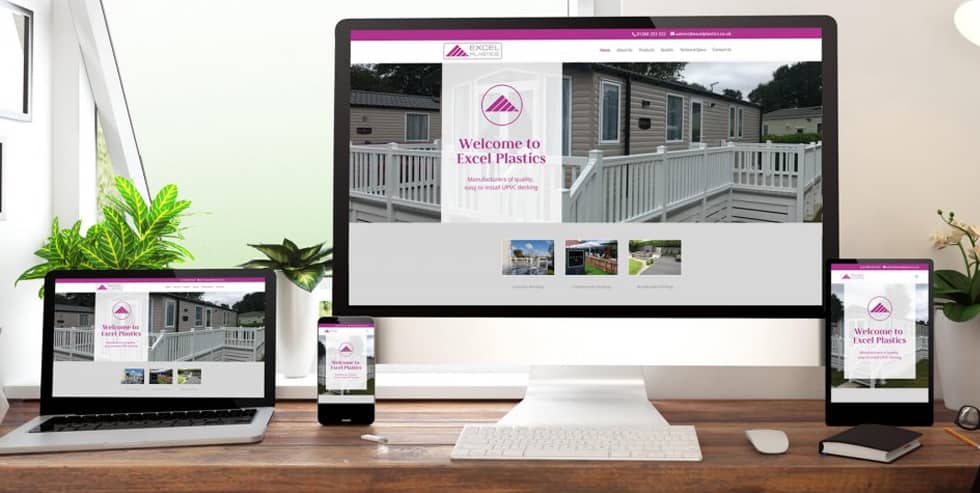Your website is often the single most important aspect of promoting your business. In an ever-evolving digital world, most businesses big or small point audiences in the direction of their website to learn more about them, whether that’s at networking events handing over your business card or through other marketing communications. After all, your website is your digital home, a place where you have the opportunity to represent your brand in its most preferred light.
In fact, most of the marketing activity you will do to promote your business, whether to generate new leads, new business or drive awareness of your services and products, will most likely drive your audience to your website. So, it’s a simple observation, but your website needs to be in top condition to represent your brand in the best way.
We know that this is easier said than done, so we’ve pulled together our top 5 tips to make your website not only look great but help make it perform better and work harder for your business. But if you just want to jump straight in and immerse yourself in creating a great website, download our Ultimate Guide which covers all the do’s and don’ts for a great performing website. It’s all there.
1. Engaging Design
When a consumer lands on your website for the first time, you want them to be impressed. After all, first impressions are very important. You don’t want to disappoint your audience with a dated or poorly designed website.
It’s important to make your homepage engaging and to the point. As soon as your audience visit, they need to know that they’ve come to the right place and that they feel comfortable there. Finding the right design that represents your business is vital, don’t try and be something you are not. If your brand is fun, make sure your website fun as well. If the business is serious, be elegant.
The design process always starts with a clear understanding of the brand and we tend to start with your why. Once you have the knowledge of what your business stands for and how you want to be perceived, then the design can begin.
2. User-friendly navigation
Looking good is great, but if your user experience is clunky and laborious, then you are going to turn off many of your visitors from exploring your website, returning for more information and certainly from recommending you to anyone else.
Ideally, you never want users to be more than two clicks away from the information they’re after. Make it easy for them to navigate and enjoy the experience on your website.
We’d always recommend making your contact details regular throughout your page so you can encourage consumers to get in touch with you if they want to learn more.
3. Memorable and relevant content
Perhaps the most important detail of your website, yet it sounds obvious to point it out. Once you peel back the layers of design and navigation, the content on your website needs to shine through. Make it relevant to your audience and present it in a memorable and engaging way.
We see lots of businesses showcase pages and pages of copy on their website thinking that their audience will read it all and leave being more informed. Wrong. Your audience has turned off. They are not interested in the granular detail of your business whilst they research you or just visiting your website for information. Be concise, punchy and creative with your information and present it in a way that is easy to digest and remember.
If you have more detailed information that is useful for your consumers, make it available in clever ways through gated content or downloadable content for your customers.
The type of content you are providing will dictate the presentation of it. Relatable imagery, videos executed in the right way and subtle animations are a great way to keep your audience engaged and will form part of your overall design that represents you and your brand.
4. Gather data and analyse it to effect
You have created a nicely designed website, that’s easy to navigate and displays engaging content (to the best of your knowledge), but what next?
Websites are ever-evolving channels of communication so you cannot afford to stand still with the content you display and the subtle tweaks you make. It’s not as fast-paced as Social Media which changes from hour-to-hour (and sometimes quicker), but you need to analyse the performance of your website regularly and evaluate your next steps.
A popular (and free!) tool to use for this, is Google Analytics. With this, you can track and analyse website traffic, page visits, onsite behaviour, conversions and a host of other features that help make your website more efficient. Gathering this type of data gives you real value and insight into how your website is performing and where to make your improvements. You may see that people are hitting your homepage and bouncing straight off which in itself tells you that your homepage is not as appealing as perhaps you thought. So messaging may need to be adjusted, layout considered.
In the end, data and knowledge is the key to maintaining and improving website performance.
5. Automated behavioural communication
And finally, our last tip encourages a more strategic and rounded approach to improving your website performance as a communication tool. Too often we see a company who sets up their website with the sole purpose to display service/product content and represent the business at arm’s length. Yes, they offer contact details but what happens then? How do they convert visitors or drive further engagement? How do you make your website more than just a hub of information?
And finally, our last tip encourages a more strategic and rounded approach to improving your website performance as a communication tool. Too often we see a company who sets up their website with the sole purpose to display service/product content and represent the business at arm’s length. Yes, they offer contact details but what happens then? How do they convert visitors or drive further engagement? How do you make your website more than just a hub of information?
Including automated triggers on your website is a great way to communicate to your audience, gather further detail of your website’s performance and tailor further activity towards your prospects.
As an example, you could include simple questions in your contact form to learn a little more about your new prospect than just their name and their email address. Asking “what service are they most interested in discussing?” will give you a valuable piece of information that you can use to continue to communicate with them around a focused subject that is relevant to their interest in your business. They may be interested to read that blog you posted recently, or a new product you’ve recently launched or it may be useful to send them that case study that represents their request perfectly. It becomes more personal to their needs and you, in turn, become more targeted with your marketing activity.
At Trident, we believe that marketing success is built on a solid foundation of research, insight and strategic knowledge to help deliver results. By working with our clients, we pinpoint key business issues and combine smart strategy, detailed planning with great creative.
Not only do we apply this ethos to our website projects but across all the services we offer within the creative, digital and print requirements of our clients, taking projects from the very start of concept through design and into delivery, covering digital build or print production.
If you would like to understand more about our agency or contact us to discuss how we can help you achieve results with your website, contact our team directly on 01455 557 766.
Tell us about your project

Top 5 things you need to know about creating a great website
Written By Adam Burrage
Managing Partner at Trident







How Can I Use Schema Markup To Improve My Website’s SEO Performance?
Schema Markup is an essential tool for improving the SEO performance of your website. By implementing Schema Markup, you can provide search engines with additional information about your content, making it easier for them to understand and display your website in...

What Are Some Ethical Concerns Around SEO Practices, And How Can I Avoid Unethical Tactics?
In the ever-evolving digital landscape, search engine optimisation (SEO) plays a crucial role in ensuring a website's visibility and success. However, in the pursuit of higher rankings and increased traffic, ethical concerns often arise. SEO professionals need to...








































